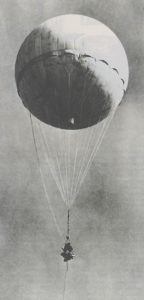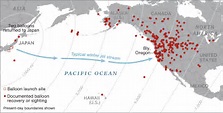Only four months after Pearl Harbor, a squadron of Mitchell B-25 bombers took off from the deck of the aircraft carrier USS Hornet. Destination: the Japanese capital of Tokyo. Lead by General Jimmy Doolittle, the raid served notice on the Japanese that contrary to what their leaders had told them, they weren’t invincible. The raid didn’t cause extensive damage on the capital, but it did wonders for morale in the U.S.
Furious and embarrassed, the Japanese military leadership felt they had to strike the U.S. homeland in retaliation as soon as possible. The continental U.S. was out of bomber range. From the fertile mind of Major General Sueyoshi Kusaba of the 9th Army Technical Research Laboratory a bizarre plan emerged:
The “Fu-Go” (revenge) weapon.
9,000 hydrogen “fusen bakudan” balloons were constructed from mulberry paper and glued together with a potato flour paste. Production was delayed when it was discovered hungry workers were eating the paste.
The balloons were 33 feet in diameter and carried a payload of 1,000 lbs., consisting of one 15-kilogram anti-personnel bomb and two incendiary devices. They were rigged to fly between 30,000 and 38,000 feet on the high altitude easterly jet stream towards the U.S.
On November 3rd, 1944, the first balloons were released. They reached the U.S. two days later. Only 285 confirmed sightings were made over a wide area, from the Aleutian Islands to Mexico. Experts believed that about 1,000 actually made landfall somewhere.
The U.S. government muzzled the media about reporting on the balloons. This averted any negative psychological damage at home and gave the Japanese the impression that the attack was a failure.
U.S. air reconnaissance discovered the plants in Japan that were the source of hydrogen production. A B-29 bombing raid effectively destroyed them.
With their production plants out of business, the Japanese ceased production of the balloons.
The Fu-go Weapon became Fu-gone.
The Japanese propaganda broadcasts announced great fires in the U.S. and an American public in a panic, but the bombs actually caused little damage. They caused fires in some areas and a few explosions occurred. The only reported casualties were a group of Sunday school students on a fishing trip in Oregon who were killed when they discovered a grounded balloon in a forest and tried to drag it back to their camp.
Sometimes truth is weirder than fiction.


